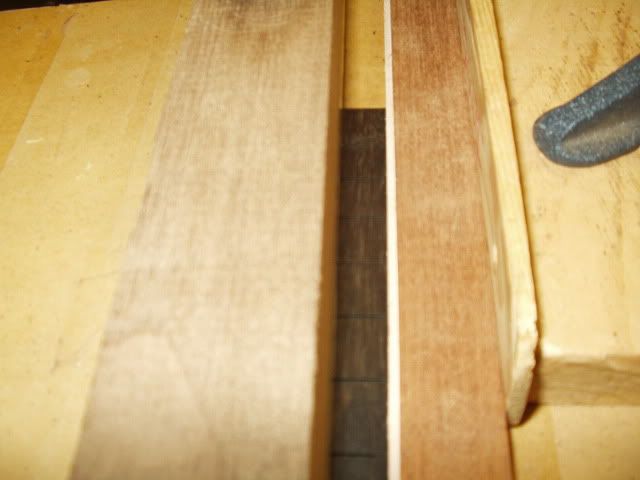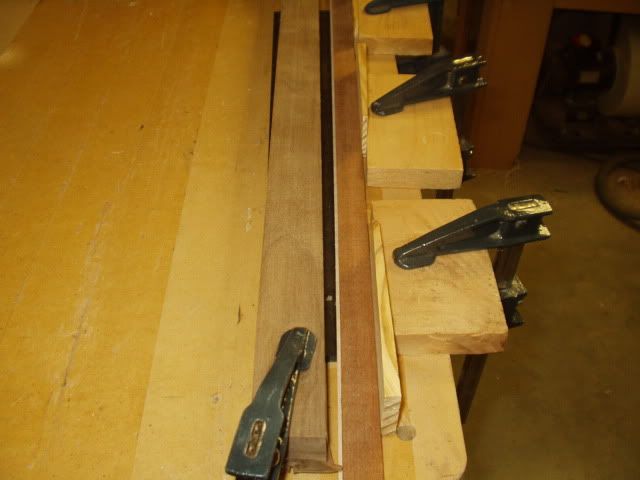I can tell you how I do it, but I would have to kill you!
Just kidding!
For fret work, I have 320 sandpaper glued to it with some 3-M spray glue. I adjust the truss rod so the neck is as flat as I can get it, mark the tops of the frets with black sharpie, and then rub the neck on the granite. As I rub back and forth, I make sure to rock from side to side so I get the full width of the fret. Since I am working blind, I check my progress with annoying frequency. It only takes a minute or two and I am done. Then I crown and polish. THe two guitars I have used this technique on have had the best, most level frets of all of my guitars. I do this with the neck off of the body so I push on the fret board extension with enough pressure to get it to fully touch the sandpaper. Seems to be working well for me.
For necks and fret boards, I swap out the 320 for 120 grit paper. You want a nice flat neck to glue the fretboard to, and you want a nice flat bottom on your fretboard, right? I attach my FB binding a tiny bit proud by putting two layers of blue tape on the bottom of the fretboard. I glue the binding flush to the work board. I then rub the bound fretboard on the granit slab to flush the binding to the bottom of the fretboard and completely flatten the bottom of the FB.
I then take the neck make pencil marks across the gluing surface, and rub that on my slab until all marks are gone. Then I know I have a very good mating surface for my fretboard. After both parts have been trued up, I can mate them with a nearly invisible glue line along the entire length of the FB. Before the granite, I wont say my joint was bad, but it wasn't always perfect like I get it now. It's another small part of a big puzzle that results in a better looking finished product.
As a bonus, most granite countertop places will definitely hace a piece of scrap you can either have or buy for cheap. Ask around. They normally throw it away so ask if there is a scrap bin to look through. I got a free 12x12 tile by asking if they had any discontinued tiles or any with a corner broken off that they were going to toss. It replaced the one I actually paid for because I dropped that one!
Flat, flat surface
Re: Flat, flat surface
Ahh, that makes sense. I was going to place my binding proud after leveling the fretboard base - then scrape it level. Your method seems pretty pragmatic. I assumed (incorrectly) that the neck and fretboard would be ready to join as soon as I was done profiling, but realized there was no reason for that to be the case. Probably saved me making an "oops" with that although I typically check everything first. ;)For necks and fret boards, I swap out the 320 for 120 grit paper. You want a nice flat neck to glue the fretboard to, and you want a nice flat bottom on your fretboard, right? I attach my FB binding a tiny bit proud by putting two layers of blue tape on the bottom of the fretboard. I glue the binding flush to the work board. I then rub the bound fretboard on the granit slab to flush the binding to the bottom of the fretboard and completely flatten the bottom of the FB.
-dean
Re: Flat, flat surface
For gluing binding to the finger board I use the same fixture that we use to join tops and back. Place clear packaging tape of the surface, nothing sticks to it. I do one edge a time (Tite-bond only needs to be clamped 30 minutes) Anyway clamping with wedges and a straight caul is one of my very favorite methods pressure is applied evenly along entire length. Slowly snug up the wedges make sure the finger-board is flat on the table -- note the bowed caul will even flatten out a less then perfect FB. As you tighten the wedged tap the binding down with a piece of popscicle stick to get it flush with the table as well. The tiny bit of glue squeeze (it any) comes off with a swipe of a scraper. since the binding needs to blend with the rest of the FB surface it is sanded flush to the fret side surface using a "flat" sanding stick --do not make the mistake of using one of the those curved sanding blocks, you can ruin the edged of the FB in an instant.
http://www.kennethmichaelguitars.com/Jo ... alves.html
I will be moving this portion of the thread to a more related topic


http://www.kennethmichaelguitars.com/Jo ... alves.html
I will be moving this portion of the thread to a more related topic


ken cierp
http://www.kennethmichaelguitars.com/
Store Front
http://www.cncguitarproducts.com/
KMG Guitar Kit Information
http://www.kennethmichaelguitars.com/ki ... ckage.html
http://www.kennethmichaelguitars.com/
Store Front
http://www.cncguitarproducts.com/
KMG Guitar Kit Information
http://www.kennethmichaelguitars.com/ki ... ckage.html
Re: Flat, flat surface
this discussion brings me back to 1978, I was working for a company. they closed one of their engineering depts. and a memo went around to anyone who wanted the 1,000lb engineering 4 x 6 dead flat, granite slab inspection table,as is! we were drooling over having it but the sheer weight made it so hard to take it. think they busted it up. would have made a great addition to any shop. :'( really wanted it!
-
Dave Bagwill
- Posts: 5952
- Joined: Tue Dec 13, 2011 7:44 pm
Re: Flat, flat surface
it was absolutely gorgeous! kinda a light ,chocolate colour. it was used for truing up optics for and quality control. it was so flat, you run the tool across, needle did not move! nice rounded edges ,about 8-9 inches thick. it haunts me that i could not ,at the time , take that. i was good friends with the QC guy, could have got it easily!
Re: Flat, flat surface
If you stop by your local granite countertop place they will quite often give away free or very cheaply scraps or miscuts.
Brian
Brian
